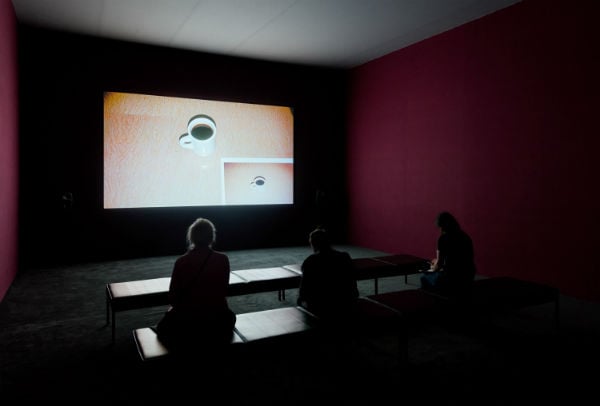Art World
Turner Prize: Confused Critics Demand Relevance!
Jury is clueless and winning artists out of touch, they say. Do they have a point?

Courtesy Tate
Jury is clueless and winning artists out of touch, they say. Do they have a point?

JJ Charlesworth


Turner Prize installation shot of Duncan Campbell, It for Others (2013).
© the artist, courtesy Tate Photography.
I won’t blow my own trumpet too much, since it was fairly obvious that Duncan Campbell was going to win this year’s Turner Prize when I reviewed the Tate’s annual art prize exhibition when it opened in October. Still, it’s nice to be right, even though I always forget to make a bet on the winner. (Campbell was a 7-4 favorite with the bookmakers, in case you’re wondering.) The 42-year-old Dublin-born filmmaker has long been a big favorite of mine, for his hypnotic, densely researched videos, which delve into the shadowy corners of British political history, resurrecting figures long forgotten, such as the American car entrepreneur John DeLorean, or the Irish republican activist Bernadette Devlin—individuals whose unusual passage through key moments in time are unearthed by Campbell’s deft reassembly of the traces they leave behind in the often crumbling audiovisual archives of the broadcast media.
So, for me, Campbell deserves his win. Which isn’t to say that his massive, 54-minute long video presented at the Turner Prize exhibition, It for Others (2013), is the easiest piece of work to take on board. A chapter-structured assembly of very different sequences that also work as individual films, it’s a sprawling essay about art, cultural value and the economic value of things, colonialism, and quite a lot more. It has Michael Clark dance company interpreting Marx’s theories of money. It has, in other words, quite a lot going on, and comes across as very, very serious, if you don’t detect the malicious humor of Campbell’s manipulation of his captive audience. Who, after all, looks at contemporary art for four minutes, let alone 54?
This has, of course, got Britain’s easily distracted commentators and critics a bit upset, since contemporary art is supposed to be fun, not hard work that might make your head ache a tiny bit. So the Guardian’s Adrian Searle, though keen on Campbell’s previous films, declares Campbell’s It for Others, “overlong, over-complicated, and with a voice-over so didactic in tone it easily alienates viewers,” “more like an academic PowerPoint lecture than an artwork,” wondering “where’s the fun of it?” Jonathan Jones, always on the side of snappy immediacy rather than too-complicated art, has decided that Campbell’s film “reduces politics to an elitist pseudo-philosophical rant.” (His preferred artist is, er, Banksy.) While the Telegraph’s music critic Mark Hudson (couldn’t the Telegraph find an art critic?), rages that “Campbell’s po-faced talking down to his audience is just the kind of thing that gives leftist dialectics a bad name.” And the BBC’s arts editor Will Gompertz opines that in contrast to the heady ’90s high-point of the Turner Prize “all that fun and games has gone, and it’s a much more sober, respectful, polite, middle aged prize. And it is full of introspection and frankly it isn’t quite as exciting.”

Duncan Campbell
Courtesy Tate
So what much of the response to Campbell’s win shows up, once more, is that in Britain, we apparently only like contemporary art that is fun, not too demanding on the old brain cells, and doesn’t want to “preach” or “lecture.” Or rather, that’s what Britain’s increasingly tetchy mainstream commentators want the rest of us to go along with. Contemporary art is only so good as a kind of daffy, feel-good spectacle that we don’t have to worry too much about. And it certainly needs to know its limits—art can’t take the form of a lecture, oh no. Nor, as Hudson bizarrely concludes, can video art be very long, wondering “whether art galleries are the best places to show 54-minute films (what are cinemas for?).” (Answer: watching The Hobbit.)
But slamming Campbell’s film for not being “proper art” is only an excuse for our middle-browed, it-hurts-when-I-think national critics to have a go at their real target—the Turner Prize—which, after 30 years, just isn’t “relevant” anymore and was always better back in the “good old days.” So, Hudson, like Gompertz, speaks for many when he nostalgises that while he “was never a great fan of the YBAs—the so-called Young British Artists, whose rise coincided with the glory days of the Turner Prize . . . at least there was some personality there, and a few larger than life characters.”
Laura Gascoigne, debating the issue rather more intelligently in the traditionalist Apollo magazine, wonders “who is the Turner Prize now relevant to? Is it an outward-facing exhibition for a general public or an inward-looking competition for art-world insiders?”
Which is to say that the worst sin today is for art to be interesting to “insiders,” rather than be entertaining for “the public.” But the Turner Prize exists to “celebrate new developments in contemporary art,” not just second-guess what gobby, half-interested pundits think the public should like. In reality, the Turner Prize reflects, admittedly often imperfectly, the shifting interests of a growing and fast-evolving global art scene, and the changing preoccupations of some often remarkable artists. In many ways, this scene has left behind the idea of a “general public,” since its own, more active audience has grown so significantly.
This doesn’t mean that the prize’s selection process isn’t getting too “ingrown”—Gascoigne is right to point out that, “the jury used to be leavened by amateurs, now it is solidly professional,” noting that the jury no longer bothers with having one or other art critics involved. (Perhaps that’s why they’re all so pissed off?) But to be “outward-facing” is, logically, to show the broader public what artists “inside” the art world are doing and why, rather than pander to what the art establishment thinks the “public” can cope with. Contemporary art in Britain has come a very long way from the media-pleasing antics of the YBAs, and that’s a good thing, even if our media class can’t get its head around the range, sophistication, and, yes, the politics of much of the art being made today. It’s time our populist opinion-formers smartened up or shipped out.